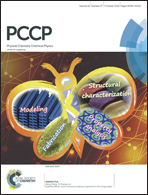Sequential inclusion of two berberine cations in cucurbit[8]uril cavity: kinetic and thermodynamic studies
Abstract
A combination of absorption and fluorescence spectroscopic studies with isothermal calorimetric titrations and stopped-flow measurements is a powerful way to reveal the thermodynamics and kinetics of inclusion complex formation with cucurbit[8]uril (CB8). The unique photophysical characteristics of berberine (B+), a pharmaceutically important natural alkaloid, were exploited to distinguish the consecutive encapsulation processes, and to examine the confinement in the CB8 cavity. The highly environment sensitive fluorescence lifetime of B+ permitted the selective detection of various cucurbituril complexes, and indicated to what extent the embedded guest was available for interaction with water. Highly stable 1 : 1 and 2 : 1 B+ : CB8 complexes were produced due to the release of the high energy water molecules from the CB8 interior, and the second binding step proved to be almost 3 times more exothermic. The favorable entropy change contributed appreciably to the driving force of 1 : 1 encapsulation. In contrast, the embedment of the second B+ in CB8 led to substantial entropy diminution. The kinetics of encapsulation was followed in real time by recording the fluorescence intensity change after rapid mixing of B+ and CB8. No evidence was found for intermediates. The rate constants of (64 ± 9) × 106, and (5.0 ± 0.5) × 106 M−1 s−1 were found for the 1 : 1 and 2 : 1 associations, whereas 3.8 ± 0.6, and 0.6 ± 0.1 s−1 were obtained as the rate constants of the reverse processes at 283 K, respectively.
![Graphical abstract: Sequential inclusion of two berberine cations in cucurbit[8]uril cavity: kinetic and thermodynamic studies](/en/Image/Get?imageInfo.ImageType=GA&imageInfo.ImageIdentifier.ManuscriptID=C4CP02919D&imageInfo.ImageIdentifier.Year=2014)


 Please wait while we load your content...
Please wait while we load your content...